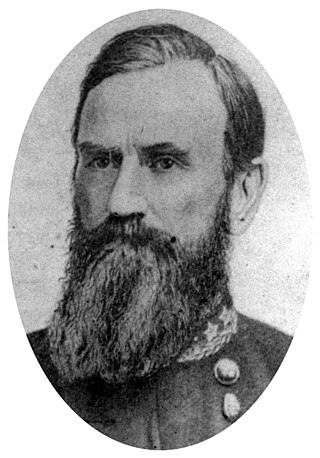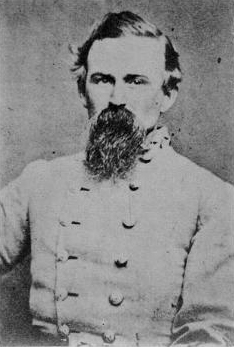
Benjamin Grubb Humphreys was an American politician from Mississippi. He was a general in the Confederate States Army during the American Civil War and served as Governor of Mississippi from 1865 to 1868, during Reconstruction.

William Barksdale was an American lawyer, newspaper editor, US Representative, and Confederate general in the American Civil War. He served four terms in the U.S. House of Representatives from 1853 to 1861.

George Pierce Doles was an American businessman and Confederate general during the American Civil War. His men played a key role on the first day of the Battle of Gettysburg in driving back the Union XI Corps.
Cobb's Legion was an American Civil War Confederate States Army unit that was raised from the state of Georgia by Thomas Reade Rootes Cobb during the summer of 1861. A legion in the Civil War usually meant a combined-arms unit, consisting of two or three branches of the military: infantry, cavalry, and artillery. When it was originally raised, the Georgia Legion comprised 600 infantrymen in the infantry battalions, 300 cavalry troopers in the cavalry battalions, and 100 artillerists in a single battery. The legion concept was not practical for Civil War armies and, soon after Robert E. Lee took command of the Army of Northern Virginia on June 1, 1862, the individual elements were assigned to other units.
The 10th Georgia Infantry Regiment was an infantry regiment that served in the Confederate States Army during the American Civil War. It participated in most of the key battles of Robert E. Lee's Army of Northern Virginia.

The Texas Brigade was an infantry formation of the Confederate Army that distinguished itself in the American Civil War. Along with the Stonewall Brigade, they were considered the Army of Northern Virginia's shock troops. It fought in every major battle of the Eastern Theater except Chancellorsville.

The 6th Wisconsin Infantry Regiment was an infantry regiment that served in the Union Army during the American Civil War. It spent most of the war as a part of the famous Iron Brigade in the Army of the Potomac.

The 3rd Arkansas Infantry Regiment, commonly known as the "Third Arkansas", was a line infantry formation of the Confederate States Army in the Eastern Theater of the American Civil War.
1st Arkansas Mounted Rifles (1861–1865) was a Confederate States Army cavalry regiment during the American Civil War. The unit was formed as a mounted infantry regiment, but was dismounted in the spring of 1862 and remained dismounted for the remainder of the war. The unit participated in the earliest battles in the western theater at Wilson's Creek and surrendered with the remnants of the Army of Tennessee in North Carolina in April 1865.

The 18th Georgia Infantry Regiment was an infantry regiment in the Confederate Army during the American Civil War. Originally brigaded with the three Texas regiments of John Bell Hood's Texas Brigade, it was transferred to Thomas R.R. Cobb's Georgia Brigade after the Battle of Antietam in late 1862. After General Cobb was mortally wounded at the Battle of Fredericksburg, the original colonel of the 18th Georgia, William T. Wofford, became Brigadier General of the Georgia Brigade.
The 141st Regiment Pennsylvania Volunteer Infantry was a volunteer infantry regiment that fought in the Union Army during the American Civil War. The regiment served in the Army of the Potomac in the Eastern Theater and was heavily engaged in the second day of fighting at the Peach Orchard outside of Gettysburg.

John Calvin Fiser was an American merchant and soldier. He served as an officer in the Confederate Army during the American Civil War, fighting in both the Eastern as well as the Western theaters. Fiser was seriously wounded five times in the conflict, losing an arm in 1863's Battle of Fort Sanders, and he was appointed a general officer late in the war; however, the appointment was never confirmed by the Confederate Senate. Afterward he returned to his business interests and was active in Confederate veterans organizations.

The 25th Arkansas Infantry was an infantry regiment of the Confederate States Army during the American Civil War. The unit was originally organized as Turnbull's 11th Arkansas Infantry Battalion. Upon being increased by the required number of companies the battalion was organized as the 30th Arkansas Infantry Regiment but was later redesignated as the 25th Arkansas Infantry. There were two regiments officially designated as the 30th Arkansas Infantry. The other "30th Arkansas" served west of the Mississippi River, in the Department of the Trans-Mississippi and was also known as 5th Trans-Mississippi Regiment or the 39th Arkansas or Rogan's Arkansas Cavalry during Price's 1864 Missouri Expedition.

Brigadier-General Nathaniel Harrison Harris was a senior officer of the Confederate States Army who commanded infantry in the Eastern theater of the American Civil War.
The 19th Mississippi Infantry Regiment an infantry formation of the Confederate States Army during the American Civil War. As part of the Army of Northern Virginia, the 19th Regiment fought in numerous battles of the Eastern Theater. The Regiment was successively commanded by Colonels Christopher Mott, Lucius Lamar, Nathaniel Harris, Thomas Hardin, and Richard Phipps.

The Louisiana Guard Battery was an artillery unit recruited from volunteers in Louisiana that fought in the Confederate States Army during the American Civil War. Formed from an infantry company sent to fight in the Eastern Theater of the American Civil War, it was converted to an artillery company in July 1861. The battery fought at Cedar Mountain, Second Bull Run, Antietam, and Fredericksburg in 1862, and at Chancellorsville, Second Winchester, and Gettysburg in 1863. Most of the soldiers and all of the battery's guns were captured at Rappahannock Station on 7 November 1863. The surviving gunners manned heavy artillery pieces in the defenses of Richmond, Virginia, and the battery's remnant surrendered at Appomattox.

The 8th Louisiana Infantry Regiment was a unit of volunteers recruited in Louisiana that fought in the Confederate States Army during the American Civil War. Formed in June 1861, the regiment was sent to fight in the Eastern Theater of the American Civil War. Joining a brigade of Louisiana regiments, it fought in Jackson's Valley campaign and at Gaines' Mill, Malvern Hill, Second Bull Run, Antietam, and Fredericksburg in 1862. The regiment served at Chancellorsville, Second Winchester, Gettysburg in 1863. At Rappahannock Station in November 1863, most of the regiment was captured. The unit fought at the Wilderness, Spotsylvania, Cold Harbor, and the Valley campaigns of 1864. It served at Petersburg starting in December 1864 and surrendered at Appomattox in April 1865.
The 16th Mississippi Infantry Regiment was a unit of the Confederate States Army from southern Mississippi that participated in the Eastern theater of the American Civil War as part of the Army of Northern Virginia. The 16th Regiment fought in numerous battles, taking heavy casualties at Antietam and Spotsylvania Court House before surrendering after Union troops broke through the defenses of Petersburg, Virginia, on April 2, 1865.
The 12th Mississippi Infantry Regiment was a Confederate infantry regiment from Mississippi. As part of the Army of Northern Virginia, the 12th Mississippi fought in many battles of the Eastern theater of the American Civil War before surrendering in April 1865.
The 13th Mississippi Infantry Regiment was a unit of the Confederate States Army from Mississippi. As part of the Army of Northern Virginia, the 13th Mississippi took part in many battles of the Eastern theater of the American Civil War, as well as some battles in Georgia and Tennessee. The 13th Mississippi Regiment surrendered at Appomattox Court House on April 9, 1865.












